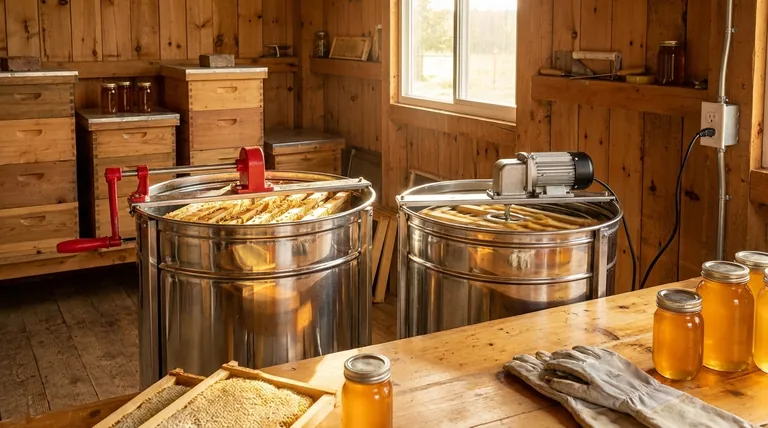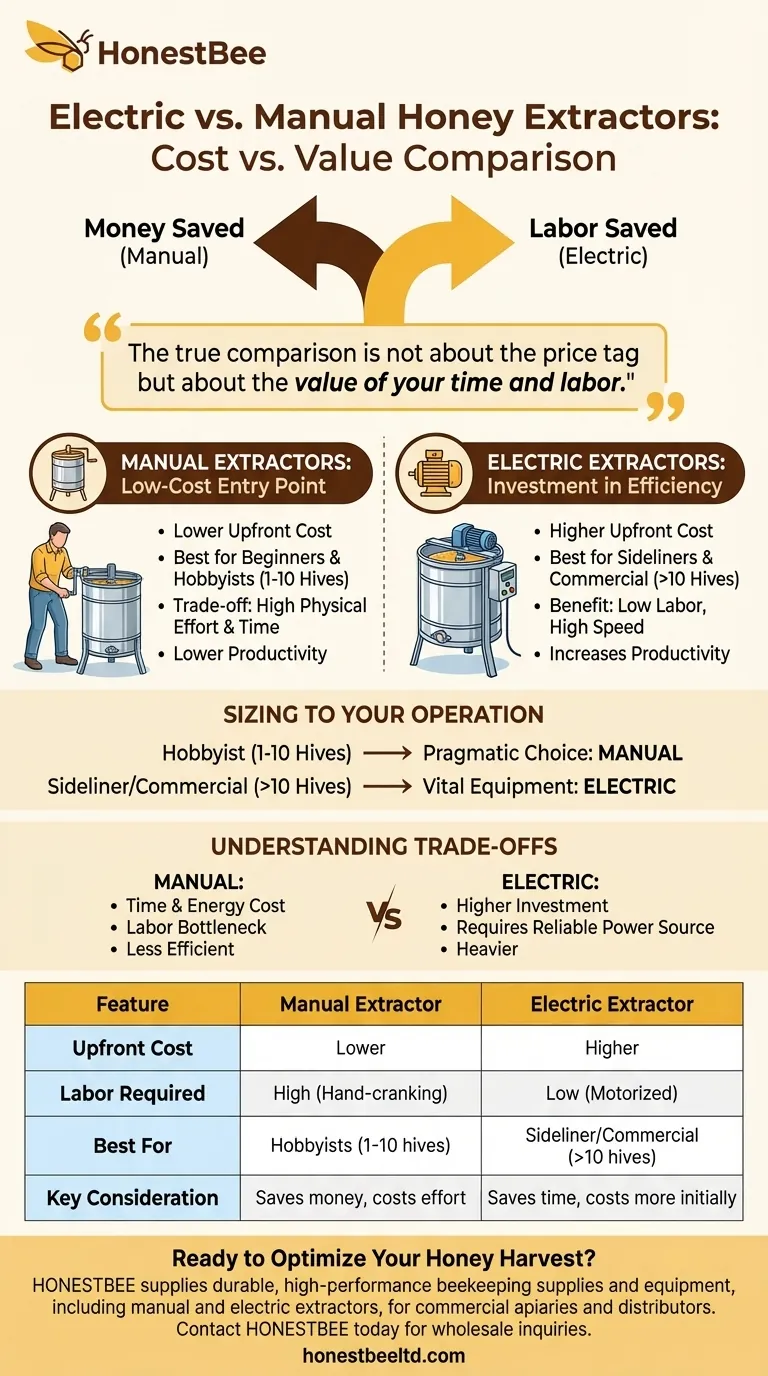At a glance, electric honey extractors have a significantly higher upfront purchase price than their manual counterparts. This initial cost is driven by the inclusion of a motor, more complex components, and features designed for higher efficiency, whereas the simpler, hand-cranked design of manual extractors makes them the more budget-friendly option.
The true comparison is not about the price tag but about the value of your time and labor. A manual extractor costs less money, while an electric extractor costs less effort, making the decision a strategic choice based on the scale of your beekeeping operation.

The Core Difference: Money vs. Labor
The decision between an electric and manual extractor hinges on how you value your resources. One saves you money upfront, while the other saves you time and physical energy during every harvest.
Manual Extractors: The Low-Cost Entry Point
A manual extractor is operated with a hand crank. You provide the power to spin the frames and extract the honey.
This design makes them the most cost-effective option, ideal for beginners, hobbyists, or beekeepers managing a small number of hives—typically fewer than ten. The initial financial barrier is low.
The trade-off is clear: what you save in money, you spend in physical effort and time. Cranking for extended periods can be strenuous, especially with multiple hives to harvest.
Electric Extractors: An Investment in Efficiency
An electric extractor uses a motor to spin the basket, automating the most labor-intensive part of the process.
This convenience comes at a higher purchase price. However, for commercial beekeepers or those with a rapidly growing apiary, this cost is often justified by the immense savings in time and labor.
The ability to set a speed and walk away allows you to perform other tasks, such as uncapping the next batch of frames. This dramatically increases productivity during the critical and time-sensitive harvest period.
Sizing the Extractor to Your Operation
The "right" choice is entirely dependent on the size and ambition of your beekeeping.
For the Hobbyist (1-10 Hives)
If you manage a few hives, the volume of honey to be extracted is manageable. The time spent hand-cranking a manual extractor is minimal in the grand scheme of your beekeeping year.
In this context, the significant price jump for an electric model is often difficult to justify. A manual extractor is the pragmatic and economical choice.
For the Sideliner or Commercial Beekeeper (>10 Hives)
Once your hive count enters the double digits, harvesting becomes a major operation. Time is a critical bottleneck, and physical fatigue becomes a real factor.
Here, an electric extractor transforms from a luxury into a vital piece of production equipment. The reduction in labor and the sheer speed of extraction directly impact your ability to process your harvest efficiently.
Understanding the Trade-offs
Beyond the initial price, there are practical considerations and hidden costs to weigh for each type.
The True Cost of a Manual Extractor
The primary "cost" is your time and energy. For a large harvest, this can mean hours or even days of hard physical work.
This labor bottleneck can limit the number of hives you can comfortably manage. It is also less efficient, as a consistent, high-speed spin from an electric model often extracts slightly more honey per frame.
The Practicalities of an Electric Extractor
The most obvious downside is the higher upfront investment. They are also heavier and require more storage space.
Crucially, you need a reliable power source. For beekeepers with apiaries in remote, off-grid locations, this can be a significant logistical challenge requiring a generator or battery system.
Making the Right Choice for Your Goal
Ultimately, the best extractor aligns with your operational goals.
- If your primary focus is minimizing upfront cost for a small hobby apiary: A manual extractor is the clear and logical choice.
- If your primary focus is saving time and reducing physical strain for a growing operation: An electric extractor is a worthwhile investment that pays for itself in efficiency.
- If your primary focus is maximizing productivity for a commercial business: An electric extractor is not a luxury but a necessary tool for a streamlined workflow.
Choosing the right extractor is an investment in your beekeeping workflow, not just a purchase.
Summary Table:
| Feature | Manual Extractor | Electric Extractor |
|---|---|---|
| Upfront Cost | Lower | Higher |
| Labor Required | High (Hand-cranking) | Low (Motorized) |
| Best For | Hobbyists (1-10 hives) | Sideliner/Commercial (>10 hives) |
| Key Consideration | Saves money, costs effort | Saves time, costs more initially |
Ready to Optimize Your Honey Harvest?
Whether you're a hobbyist managing a few hives or a commercial apiary scaling up production, choosing the right extractor is crucial for your efficiency and profitability. HONESTBEE supplies durable, high-performance beekeeping supplies and equipment—including a range of manual and electric honey extractors—to commercial apiaries and beekeeping equipment distributors through our wholesale-focused operations.
Let our experts help you select the perfect extractor for your specific needs and scale. Contact HONESTBEE today to discuss your requirements and get a quote!
Visual Guide

Related Products
- HONESTBEE 3-Frame Manual Acrylic Honey Extractor
- HONESTBEE 72 Frame Industrial Electric Honey Extractor for Beekeeping
- Electric 8 Frame Honey Spinner Extractor Equipment for Beekeeping
- Commercial Electric 12 Frame Honey Extractor Spinner Motorized Honey Extractor
- electric honey extractor honey centrifuge 3 frame honey extractor stainless steel honey frame extractor
People Also Ask
- What size honey extractor do I need? Match Frame Capacity to Your Hives for Maximum Efficiency
- How do you manually extract honey? Choose the Best Method for Your Hive
- What is a fun and easy alternative to using a honey extractor for harvesting honey? Try the Crush and Strain Method
- What machines are needed in beekeeping besides basic tools? Scale Your Honey Harvest Efficiently
- What equipment is used for honey harvest? Essential Tools for Every Beekeeper



















